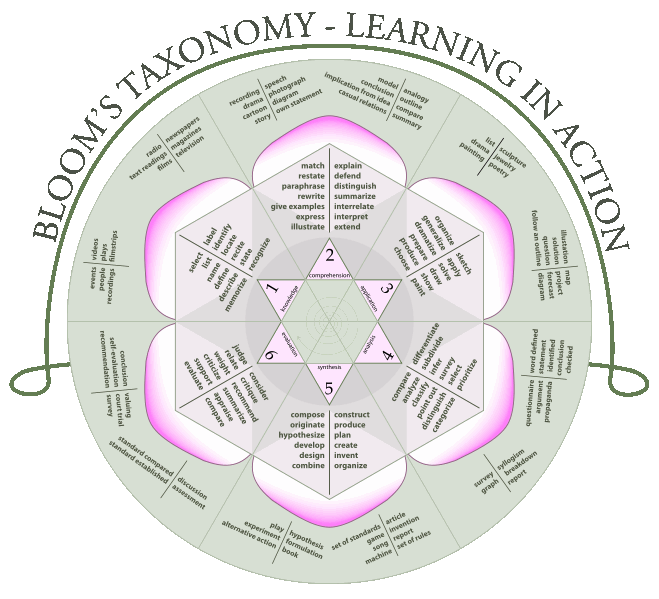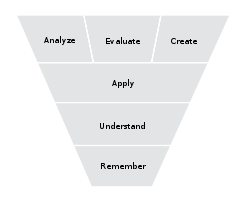A taxonomy of learning
Bloom's taxonomy is (see the film) an educational psychology approach to cognitive, critical and creative thinking developed by Benjamin Bloom's studies of how people learn most effectively.
Below are the intelligence exercise levels from the array of affective, psychomotor and cognitive domains about which these researchers wrote.
table for scoring | explanation | sequence of steps | illustration
![]()
Criteria and Method
Because all learning is an exercise in memory, connectivity, and affective appreciation for differences both subtle (fine grained) and obvious (coarse grained), the steps involved in mastering subjects are desirable to consider in some detail.
Use these steps to judge what you read, see, and find on the internet.
more on method
methods described
table for scoring | explanation | sequence of steps | illustration
![]()
Six sequential and contingent steps
These half-dozen steps are a rudimentary method for acquiring knowledge through practicing these cognitive skills in order to nourish critical reading and thinking.
We start with the basic foundation demanding the simplest skills and build on each subsequent, but contingent and sufficient demonstrations of newly developed skills.
Like a set of stairs, these steps move from lower order thinking to higher order thinking processes to move us away from literal, through metaphorical, and symbolic levels of thought. Experts call this critical thinking because the participant needs to make judgments when analyzing, evaluating, and creating knowledge in order to inform one another.
Remembering
1) Do recall what stands out because it is important in any paragraph, tell and show how the paragraph relates to the chapter & refer to what the chapter advances as part of the larger point of the article or book.
An important part of recall is to correct errors and discover inconsistent explanations.
Understanding moments
2) Restate the information in your own words, taking care to anchor your translation in the author's thoughts, examples, argument, or phrases.
- Define terms with examples.
- Do point to evidence that is more versus less convincing.
- Identify an argument and how it is salient.
- List the evidence for or against the point's raised.
Applying
By nature, knowledge that is not used is often forgotten, or replaced by usable information.
3) Demonstrate the application of knowledge by making logical connections, discover arguments, and solve problems as presented by the authors, discussions, lecture, film, or questions.
Since any problem is defined as the perceivable difference between an existing and a desired state of affairs, follow these steps:
- find and restate the matter under consideration as you understand it.
- describe the existing status of a situation making a point, examining a case, or proposing evidence for the problem's importance.
- present the alternative ways to achieve the desired outcome if the concepts, ideas, or facts were put together in a different and more apparent way.
Analyzing
4) You best demonstrate this by finding an author's argument and breaking it down into its necessary parts or component pieces and making a counter argument or complementary case of your own based on the facts.
For further discussion.
An example of Descarte's analysis.
Synthesis & evaluation
5) Synthesizing and evaluating:
This happens when you show how you bring the pieces of your evidence for arguments together having analyzed their significant contribution to the concepts for or against the author's point, or questions raised by a text's description of a situation, case, or events.
Evaluation is demonstrated by explaining (steps 3 & 4) what you rest your case upon, and showing how you judged what pieces to put where to fit into a logical, if not fully rational (could be a paradox) whole.
Creating (new) knowledge
Critical thinking must be demonstrated here as we are making use of old ideas, such as the labor theory of value, or the metaphor of the immaculate conception, or the argument for the equality of all people despite the inequity of their abilities. We make use of these older concepts for the purpose of advancing knowledge by discoveries, rediscoveries, or the re-assembly of older concepts to overcome prevailing bias, or prejudices that obscure deeper understanding of our conditions or our world.
table for scoring | explanation | sequence of steps | illustration
table of values
| Name | level & meaning | points | values |
|---|---|---|---|
| remember | lowest | 0 | F |
| understand | base, clarify & organize | 1 | D |
| apply | translate, | 2 | C |
| analyze | high, take apart; inform | 3 | B |
| synthesize | higher, put together, evaluate | 4 | A |
| create | highest, discover & relate | 5 | |
| Score |
table for scoring | explanation | sequence of steps | illustration

table for scoring | explanation | sequence of steps | illustration


